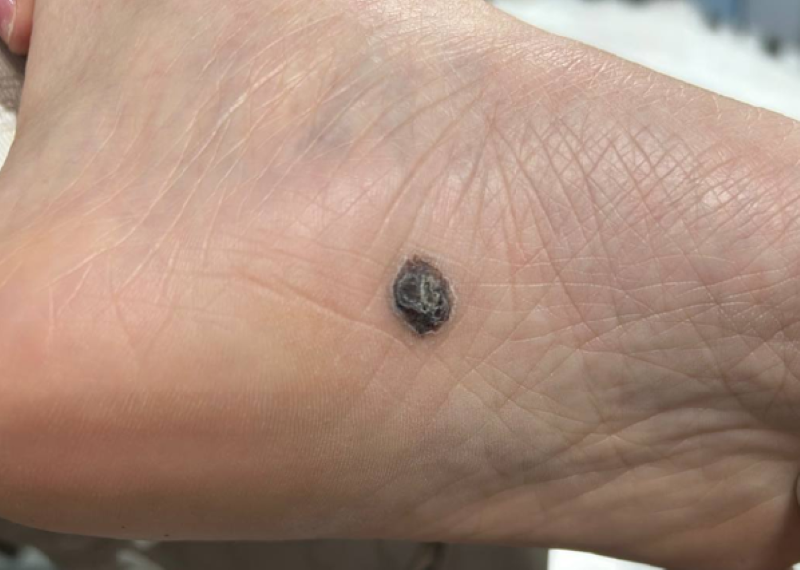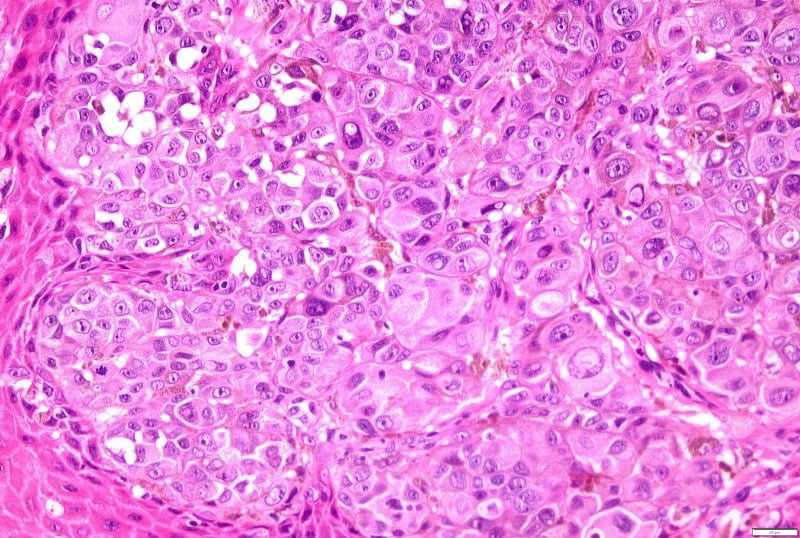
Mole on the sole of the patient's left foot with many unusual points - Photo: Provided by the hospital
On April 29, MEDLATEC General Hospital ( Hanoi ) announced that it had just admitted Ms. CTHN (47 years old, Hanoi) who had melanoma, but for a long time thought it was just a normal mole on the bottom of her foot.
Recently, the mole started to get bigger and the surface became rough, so she went to the hospital for a check-up and found out she had melanoma.
Ms. N. said that recently she discovered that the mole on the sole of her foot was increasing in size. Realizing the abnormality, she decided to go to the hospital.
With the doctor's experience, through clinical examination, the malignant nature of the mole was detected with the following signs: size about 1cm, asymmetrical, rough dark brown surface.
The patient was indicated by the doctor to have surgery to remove the entire tumor for histopathological evaluation.
Histopathological analysis results showed that tumor cells had malignant characteristics such as large, polymorphic nuclei, red nucleoli, scattered mitotic nuclei, cytoplasm containing melanin pigment, invading the epidermis and reaching the reticular dermis.
These characteristics led the pathologist to diagnose melanoma. To confirm the diagnosis and differentiate it from other malignant tumors, Ms. N. was further ordered to perform immunohistochemical staining on the surgical specimen.
The tumor results revealed melanoma markers such as S100, HMB45, Melan A. The doctor made a definitive diagnosis of melanoma.
Currently, after tumor removal surgery, Ms. N's health is stable. The doctor advised her on follow-up and scheduled a follow-up appointment after 3 months.

Histopathological examination images of the patient showed results pointing towards a diagnosis of melanoma - Photo: Provided by the hospital
What are the signs that a mole is at risk of malignancy?
Doctors say that on the human body, there are often congenital or acquired skin lesions such as freckles, moles, changes in skin pigmentation...
Most of these lesions are benign, however, in some cases these lesions can transform into malignant forms, so it is necessary to monitor their progression.
Accordingly, signs to recognize moles at risk of malignancy include:
1. Asymmetry: Moles are usually round or oval, with two sides symmetrical, but moles with a risk of malignancy have two sides that are not symmetrical.
2. Abnormal borders : Benign moles have soft, rounded borders, but atypical moles have borders that are map-shaped, zigzag, and irregular.
3. Inconsistent color: Instead of being just brown or black, moles that are at risk of malignancy may have dark spots, light spots, black, brown, red, blue, or depigmented areas.
4. Large size: Common moles are less than 6mm in size. Moles larger than 6mm are considered to have risk factors.
5. Abnormal development : For moles with the risk of malignancy, the time it takes to change from small to large is very short. In just a few months, the mole can increase several times.
6. In addition, there are some other characteristics such as: ulcers, bleeding, rough surface, itching or pain...
In addition to identifying suspicious signs with the naked eye, people need to immediately go to reputable medical facilities to perform necessary imaging tests to serve a definitive diagnosis.
Source











![[Photo] President Luong Cuong attends special political-artistic television show "Golden Opportunity"](https://vstatic.vietnam.vn/vietnam/resource/IMAGE/2025/8/22/44ca13c28fa7476796f9aa3618ff74c4)






















































![[Photo series] Close-up of a series of 'huge' aircraft fuel tanks at Long Thanh Airport](https://vstatic.vietnam.vn/vietnam/resource/IMAGE/2025/8/23/36dd3d00663540209336017dafb42441)
















Comment (0)